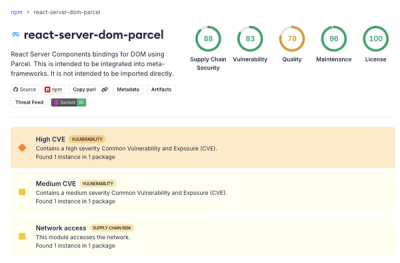
Security News
New React Server Components Vulnerabilities: DoS and Source Code Exposure
New DoS and source code exposure bugs in React Server Components and Next.js: what’s affected and how to update safely.
axios-extensions
Advanced tools
A non-invasive, simple, reliable collection of axios extension
v3.x has a lot of api changes, if you are looking for v2.x doc, see here
Not working with axios v0.19.0 as its custom config bug, See https://github.com/axios/axios/pull/2207.
npm i axios-extensions -S
or
yarn add axios-extensions
or
// exposed as window['axios-extensions']
<script src="https://unpkg.com/axios-extensions/dist/axios-extensions.min.js"></script>
import axios from 'axios';
import { cacheAdapterEnhancer, throttleAdapterEnhancer } from 'axios-extensions';
// enhance the original axios adapter with throttle and cache enhancer
const http = axios.create({
baseURL: '/',
headers: { 'Cache-Control': 'no-cache' },
adapter: throttleAdapterEnhancer(cacheAdapterEnhancer(axios.defaults.adapter))
});
It is highly recommended to enable the request logging recorder in development environment(disabled by default).
new webpack.DefinePlugin({
'process.env.LOGGER_LEVEL': JSON.stringify('info')
})
// package.json
"scripts": {
"start": "cross-env LOGGER_LEVEL=info node server.js"
}
Makes axios cacheable
cacheAdapterEnhancer(adapter: AxiosAdapter, options: Options): AxiosAdapter
Where adapter is an axios adapter which following the axios adapter standard, options is an optional that configuring caching:
| Param | Type | Default value | Description |
|---|---|---|---|
| enabledByDefault | boolean | true | Enables cache for all requests without explicit definition in request config (e.g. cache: true) |
| cacheFlag | string | 'cache' | Configures key (flag) for explicit definition of cache usage in axios request |
| defaultCache | CacheLike | new LRUCache({ maxAge: FIVE_MINUTES, max: 100 }) | a CacheLike instance that will be used for storing requests by default, except you define a custom Cache with your request config |
cacheAdapterEnhancer enhances the given adapter and returns a new cacheable adapter back, so you can compose it with any other enhancers, e.g. throttleAdapterEnhancer.
import axios from 'axios';
import { cacheAdapterEnhancer } from 'axios-extensions';
const http = axios.create({
baseURL: '/',
headers: { 'Cache-Control': 'no-cache' },
// cache will be enabled by default
adapter: cacheAdapterEnhancer(axios.defaults.adapter)
});
http.get('/users'); // make real http request
http.get('/users'); // use the response from the cache of previous request, without real http request made
http.get('/users', { cache: false }); // disable cache manually and the the real http request invoked
const http = axios.create({
baseURL: '/',
headers: { 'Cache-Control': 'no-cache' },
// disable the default cache and set the cache flag
adapter: cacheAdapterEnhancer(axios.defaults.adapter, { enabledByDefault: false, cacheFlag: 'useCache'})
});
http.get('/users'); // default cache was disabled and then the real http request invoked
http.get('/users', { useCache: true }); // make the request cacheable(real http request made due to first request invoke)
http.get('/users', { useCache: true }); // use the response cache from previous request
Note that if you are using custom cache flag and typescript, you may need to add the typing declaration like below:
import { ICacheLike } from 'axios-extensions';
declare module 'axios' {
interface AxiosRequestConfig {
// if your cacheFlag was setting to 'useCache'
useCache?: boolean | ICacheLike<any>;
}
}
Besides configuring the request through the cacheAdapterEnhancer, we can enjoy more advanced features via configuring every individual request.
import axios from 'axios';
import { cacheAdapterEnhancer, Cache } from 'axios-extensions';
const http = axios.create({
baseURL: '/',
headers: { 'Cache-Control': 'no-cache' },
// disable the default cache
adapter: cacheAdapterEnhancer(axios.defaults.adapter, { enabledByDefault: false })
});
http.get('/users', { cache: true }); // make the request cacheable(real http request made due to first request invoke)
// define a cache manually
const cacheA = new Cache();
// or a cache-like instance
const cacheB = { get() {/*...*/}, set() {/*...*/}, del() {/*...*/} };
// two actual request will be made due to the different cache
http.get('/users', { cache: cacheA });
http.get('/users', { cache: cacheB });
// a actual request made and cached due to force update configured
http.get('/users', { cache: cacheA, forceUpdate: true });
Note: If you are using typescript, do not forget to enable "esModuleInterop": true and "allowSyntheticDefaultImports": true for better development experience.
Throttle GET requests most once per threshold milliseconds
throttleAdapterEnhancer(adapter: AxiosAdapter, options: Options): AxiosAdapter
Where adapter is an axios adapter which following the axios adapter standard, options is an optional object that configuring throttling:
| Param | Type | Default value | Description |
|---|---|---|---|
| threshold | number | 1000 | The number of milliseconds to throttle request invocations to |
| cache | CacheLike | new LRUCache({ max: 10 }) | CacheLike instance that will be used for storing throttled requests |
Basically we recommend using the throttleAdapterEnhancer with cacheAdapterEnhancer together for the maximum caching benefits.
Note that POST and other methods besides GET are not affected.
throttleAdapterEnhancer(cacheAdapterEnhancer(axios.defaults.adapter))
Check David Corbacho's article to learn more details about throttle and how it differs from debounce.
import axios from 'axios';
import { throttleAdapterEnhancer } from 'axios-extensions';
const http = axios.create({
baseURL: '/',
headers: { 'Cache-Control': 'no-cache' },
adapter: throttleAdapterEnhancer(axios.defaults.adapter, { threshold: 2 * 1000 })
});
http.get('/users'); // make real http request
http.get('/users'); // responsed from the cache
http.get('/users'); // responsed from the cache
setTimeout(() => {
http.get('/users'); // after 2s, the real request makes again
}, 2 * 1000);
Retry the failed request with special times
retryAdapterEnhancer(adapter: AxiosAdapter, options: Options): AxiosAdapter
Where adapter is an axios adapter which following the axios adapter standard, options is an optional that configuring caching:
| Param | Type | Default value | Description |
|---|---|---|---|
| times | number | 2 | Set the retry times for failed request globally. |
import axios from 'axios';
import { retryAdapterEnhancer } from 'axios-extensions';
const http = axios.create({
baseURL: '/',
headers: { 'Cache-Control': 'no-cache' },
adapter: retryAdapterEnhancer(axios.defaults.adapter)
});
// this request will retry two times if it failed
http.get('/users');
// you could also set the retry times for a special request
http.get('/special', { retryTimes: 3 });
FAQs
make axios great again
The npm package axios-extensions receives a total of 22,903 weekly downloads. As such, axios-extensions popularity was classified as popular.
We found that axios-extensions demonstrated a not healthy version release cadence and project activity because the last version was released a year ago. It has 1 open source maintainer collaborating on the project.
Did you know?

Socket for GitHub automatically highlights issues in each pull request and monitors the health of all your open source dependencies. Discover the contents of your packages and block harmful activity before you install or update your dependencies.

Security News
New DoS and source code exposure bugs in React Server Components and Next.js: what’s affected and how to update safely.

Security News
Socket CEO Feross Aboukhadijeh joins Software Engineering Daily to discuss modern software supply chain attacks and rising AI-driven security risks.

Security News
GitHub has revoked npm classic tokens for publishing; maintainers must migrate, but OpenJS warns OIDC trusted publishing still has risky gaps for critical projects.